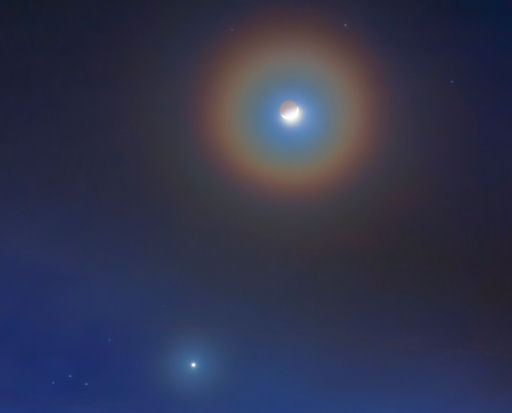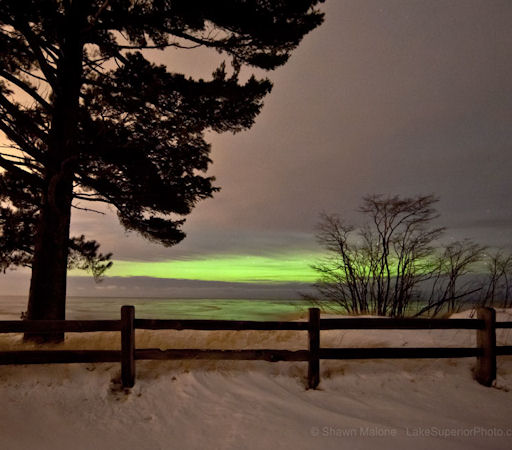ASTEROID FLYBY: Newly-discovered asteroid 2012 BX34 is flying past Earth today only 77,000 km (0.2 lunar distances) away. There is no danger of a collision with the 14-meter wide space rock. Advanced amateur astronomers might be able to observe the flyby as the bus-sized asteroid brightens to 14th magnitude just before closest approach on Jan. 27th at 1530 UT. [3D orbit] [ephemeris] [images: #1]
CORONA CONJUNCTION: "Last night I went outside to photograph the Venus-Moon conjunction, and I got more than I bargained for," reports Robert Arn of Fort Collins, Colorado. "The Moon and Venus both had an incredible corona surrounding them. The sight was beyond words (but not beyond pictures)." He recorded the scene in this 5-second exposure @ ISO 400:
Coronas are caused by tiny water droplets in thin clouds, which diffract the light of bright heavenly bodies to produce iridescent halos, as shown above. Seeing one corona in the night sky is not uncommon; however, seeing two in close proximity is a rare treat. Another "corona conjunction" could be in the offing. The Moon is moving past Venus for a meet-up with Jupiter on Jan. 29th. If the two align behind a moist, thin cloud--voilà!
more Venus-moonshots: from Petr Horalek of the Academy of Sciences of the Czech Republic; from Mike O'Leary of San Diego, CA; from Francis Audet of Quebec City, Canada; from Gregg Alliss of Marion, Iowa; from Becky Ramotowski of Tijeras, New Mexico;
AURORAS OVER THE USA: The geomagnetic storm of Jan. 24th died out before night fell over North America--or did it? According to reports still trickling in, auroras were reported not only in Canada, but also in some of the lower 48 US states. Shawn Malone of Marquette, Michigan, took this picture looking north from the shores of Lake Superior:
"I got to view a slice of the aurora through a tiny opening in an otherwise completely overcast sky," says Malone. "It appeared to be a pretty decent display."
Prompted by the CME warning, Mike Hollingshead of Nebraska drove 450 miles to the Badlands National Park of South Dakota hoping to catch a glimpse of the auroras. He got more than he bargained for: "While I waited for some sign of auroras, the most amazing fireball I've ever seen blasts down. It flashed brightly and illuminated the terrain around me." Later, the auroras made a belated appearance, turning the badland sky green.
More auroras could be in the offing. A solar wind stream is heading for Earth, due to arrive on Jan. 28-29. NOAA forecasters estimate a 15% chance of geomagnetic storms at high latitudes. Aurora alerts: text, voice.

![]()
Solar wind
speed: 505.9 km/sec
density: 0.5 protons/cm3
explanation | more data
Updated: Today at 1426 UT
![]()
X-ray Solar Flares
6-hr max: C1 1206 UT Jan27
24-hr: C5 0642 UT Jan27
explanation | more data
Updated: Today at: 1400 UT
![]()
Sunspot 1408 is directly facing Earth, but it has a simple magnetic field that does not pose a threat for strong flares. Credit: SDO/HMI
![]()
![]()
![]()
Sunspot number: 55
What is the sunspot number?
Updated 26 Jan 2012
Spotless Days
Current Stretch: 0 days
2012 total: 0 days (0%)
2011 total: 2 days (<1%)
2010 total: 51 days (14%)
2009 total: 260 days (71%)
Since 2004: 821 days
Typical Solar Min: 486 days
Updated 26 Jan 2012
The Radio Sun
10.7 cm flux: 128 sfu
explanation | more data
Updated 26 Jan 2012
![]()
![]()
![]()
Current Auroral Oval:
![]()
Switch to: Europe, USA, New Zealand, Antarctica
Credit: NOAA/POES
![]()
![]()
![]()
Planetary K-index
Now: Kp= 2 quiet
24-hr max: Kp= 3 quiet
explanation | more data
![]()
Interplanetary Mag. Field
Btotal: 4.3 nT
Bz: 0.1 nT north
explanation | more data
Updated: Today at 1427 UT
![]()
![]()
![]()
Coronal Holes: 27 Jan 12
![]()
![]()
Solar wind flowing from the indicated coronal hole should reach Earth on Jan. 28-29. Credit: SDO/AIA.






